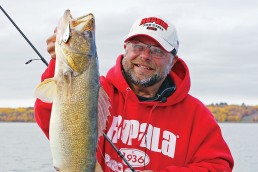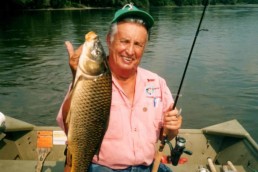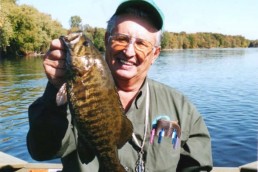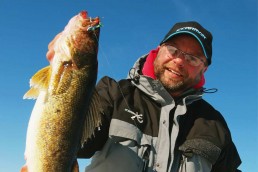The Rise of Fall’s ‘Eyes
SHARE THIS POST
Pulling crawler harnesses and snap-jigging split-tail minnows take top honors this time of year
When an artist depicts walleyes in their natural environment, their brush strokes often reveal an image of these peculiar fish practically belly to bottom while feasting on forage many fathoms below the surface. After all, it’s at a lake’s floor, in deep water, they spend the majority of their time, right? Well, not always…
Actually, it’s within this fish’s bottom-dwelling realm where ‘eyes linger very little. In fact, they’re here more when in a neutral mood after a cold front, than when searching for food. This holds especially true during the fall months.
So, where do walleyes wander when on the prowl this time of year?
The answer is twofold. As a rule, you’ll find them suspended just below the surface over their deep-water haunts, particularly in areas near rock-strewn reefs or sunken islands.
And what’s the reason for swimming so close to this structure? Because, when the mood arises, they can hightail it straight across the water column and onto the rocky humps to hunt down prey, as well.
Although there’s a large array of tactics used to catch ‘eyes when they are on the rise, two techniques stand out from my tackle boxes: trolling at a creep with crawler harnesses when the fish are suspended, and, rip-jigging split-tail jigs and lipless crankbaits when fish are hanging tight upon the rocks.
A trolling we will go
I’ve been catching walleyes from waters throughout the United States as a career since the late 1980’s. Since those early days, I’ve seen trolling tactics morph from just being an aimless pull of live-bait rigs most anywhere in the water, to narrowing down every nuance of where fish could be.
Speed, size and scent are crucial when it comes to catching walleyes when they are suspended. Thus, I’ll troll at various speeds until I get bit, and then make sure to stick to that pace. After that, I’ll start switching out blades, trying out different sizes and shapes to narrow the bite down more. I make sure my harnesses have only the freshest bait on them at all times throughout the day. The smell and taste of a fresh crawler is irresistible to most any fish.
Overall, I aim for speeds from .7 to 1.3 MPH when pulling harnesses behind my Church Tackle in-line planer boards. I’m adamant about keeping whatever tempo it is I’ve been getting bit, right down to the one-tenth of a mile-per-hour.
It’s not uncommon to see me rummaging through my tackle totes in search of new blades about every half-hour. In general, I’ll use size-3 and -4 Colorado/Indiana blades by Northland when fishing in inland lakes, and beef things up to size-5 and 6- blades, as well as adding willow blades, in the Great Lakes or reservoirs where walleyes often feed on larger shad. No matter what style, Northland’s Baitfish-Image blades are always a good choice as the holographic images give off lots of flash.
In general, I’ll uses 1-ounce in-line weights about 6 feet ahead of my spinning blades. With this amount of weight, when trolled at 1 MPH, the offering will sink down below the surface about half the amount of line out behind the board when using 12-pound-test Berkley Trilene XL monofilament. (Example: Thirty feet of line out will drop 15 feet down.)
Seeing is believing
It’s now been quite a few years that I’ve gotten the chance to see how Lowrance’s SideScan can make finding suspended fish and forage a whole lot easier. And it didn’t take long to become a believer after seeing (and catching) fish I would never have known were there without it.
Are you enjoying this post?
You can be among the first to get the latest info on where to go, what to use and how to use it!
Fish don’t always show up on standard sonar when high in the water column, due to them spooking out from under the boat and out of the transducer’s range.
SideScan, however, allows me to see fish and bait suspended just under the surface hundreds of feet to both sides in a two-dimensional illustration. And with just a couple button swipes, a GPS position can be placed over the area where the fish were seen on the screen so that, on my next pass, my lures can be right on them.
Rip ‘em up
Another place Lowrance sonar and GPS is a must is when fishing for walleyes holding tight to reefs, especially when the unit’s coupled with an SD card filled with Navionics mapping.
With this mapping technology, I can position my boat within casting distance to structure without running up on it and spooking fish.
“Rip-jigging” is the continuous swift lift and radical fall of a heavy jig while being rapidly retrieved to the boat. It’s a technique that triggers strikes from even the most lethargic fish.
One of my best ploys for fishing reefs is to cast 4- and 5-inch split-tail minnows, such as Berkley’s PowerBait Minnows and PowerBait Power Jerk Shads, on top of reefs and rip-jigging them back to the boat. Northland’s Slurp! jigheads and Thumper Jigs couple well with these bodies.
Another lure that works wonders for rip-jigging is Rapala’s Rippin’ Rap. This lure has a lot of vibration and sound, and drops through the water column quickly. It’s perfect when fish want to hit a lure with a quick fall.
But, even when using such an aggressive tactic as rip-jigging, the light bite of a walleye can still go undetected. So, I make sure to use equipment that allows me to feel every little tick.
Six- to 8-pound-test Berkley FireLine spooled onto a spinning reel that’s coupled to a 7-foot, 2-inch, medium-power Fenwick Elite Tech Walleye spinning rod is what you’ll find in my hand most often. The FireLine matched with the super-sensitive Fenwick rod allows me to feel the lightest of strikes. And, basically, I set the hook any time I feel any weight or the slightest “tick”.
Narrow focus
Looking to land more walleyes this fall? Just look up!
Pull crawler harnesses behind in-line boards when fish are high, and snap-jig softbaits and lipless crankbaits on nearby reefs and you’ll catch plenty. I promise.
MWO
SHARE THIS POST
Did you enjoy this post?
You can be among the first to get the latest info on where to go, what to use and how to use it!
Mark Martin
Mark Martin is a professional walleye tournament angler and instructor with the Ice Fishing School/Vacation series. For more information, check out his website at markmartins.net or fishingvacationschool.com.



